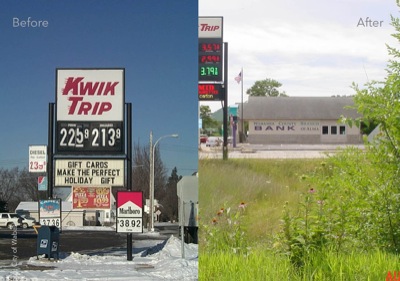
LEFT: Snow melts into pavers on the plaza at the foot of Pembroke Ave. in Wabasha. The overlook honors beloved people and cultures, connects visitors to the water and keeps polluted runoff out of the Mississippi River. CENTER: A family explores Big Jo Alley. RIGHT: Visitors stand above the National Eagle Center’s rain garden.
In 2001, demolition of the towering Big Jo Flour Mill left a gaping, rough space between Wabasha’s downtown and the Mississippi River. For the first time in more than 100 years the river was visible from the commercial district, and developers and others who enjoy Wabasha saw possibilities.
A condominium/hotel/visitor center complex was proposed by private developers. In collaboration with the City, condominiums were built by 2004. The hotel and visitor center didn’t materialize, but conversations continued and a plan emerged to transform a storefront learning center operated by EagleWatch, Inc. into a larger facility. EagleWatch, the City of Wabasha and Wabasha Port Authority proceeded to design and build Wabasha’s 15,000 square-foot National Eagle Center, which opened in 2007 and quickly drew more than 100,000 visitors each year.
During construction of the Eagle Center, the City engaged project architect LHB to lead design sessions with Wabasha residents and investors. Those conversations clarified a community vision for connecting downtown to the riverfront. Big Jo Alley was redeveloped as a result, linking the Eagle Center and downtown with brick-paved walkways, retail access and outdoor terraces. Inspired by the action, John and Marcia Bouquet came forward to honor their parents with a riverfront plaza, fountain and sculpture of Chief Wapahasha II. A riverfront interpretive trail was added and later became part of the 3000-mile Mississippi River Trail.
In real-life fashion, Wabasha’s riverfront developed “piecemeal, over time,” says city planner Molly Patterson-Lundgren of WSB & Associates. “I’m so proud of it! This small town pulled off innovative stormwater management and cultural development concepts. They took initiative, developed public/private partnerships, and ended up with more than they envisioned.”


3 Impacts of Collaboration
1) Seeing is believing | Wabasha residents and visitors now understand and value low-impact design
2) Tourism | Stormwater infrastructure helps create great places & things to do
3) Momentum | One action leads to another
AT LEFT: Beyond the riverfront, Wabasha’s Kwik Trip dramatically changed its curb appeal with a well-designed storm water retention basin.
In Wabasha, water used to pour off downtown roofs directly to the Mississippi River. Now it’s absorbed through landscaped basins, an underground catchment filter and brick-paved sidewalks, stairs, plaza and alley.

